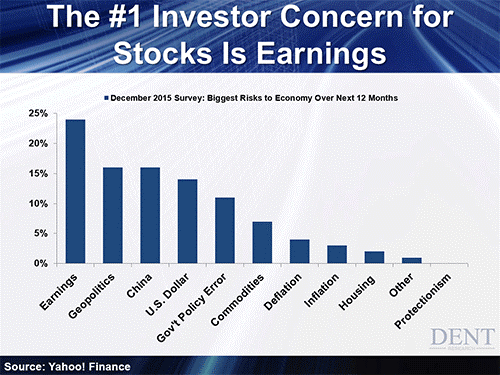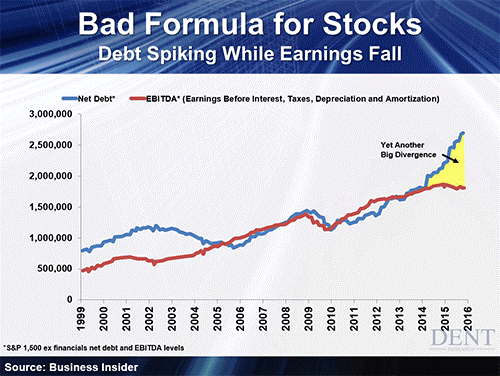Harry S. Dent Jr.'s Blog, page 120
January 22, 2016
Expect Higher Taxes As Earnings Slow
 Last week the Census Bureau reported retail sales for December, and the numbers weren’t pretty. Sales dropped 0.1% overall last month, and were down the same 0.1% when auto sales were excluded. Removing volatile gasoline sales only moved the number to flat. Making matters worse, retail sales increased a paltry 2.1% for all of 2015 – the smallest gain since 2009, and well below the 3.9% growth in 2014.
Last week the Census Bureau reported retail sales for December, and the numbers weren’t pretty. Sales dropped 0.1% overall last month, and were down the same 0.1% when auto sales were excluded. Removing volatile gasoline sales only moved the number to flat. Making matters worse, retail sales increased a paltry 2.1% for all of 2015 – the smallest gain since 2009, and well below the 3.9% growth in 2014.
The report justified our negative view on earnings. Fourth-quarter numbers should be ugly. All of this plays right into our forecast for a general market decline and tough economic conditions in the months ahead.
But it also means something else.
Higher taxes.
Over the past five years, the U.S. budget deficit, as well as those of most states, has improved. Through a combination of higher sales tax receipts, higher tax rates in general and higher capital gains taxes, government entities have pulled in a lot of cash. But the days of easy tax revenue growth are over.
Consumers aren’t spending more, and in some cases are spending less, as noted by retail sales. This cuts into sales tax growth. Falling markets put the kibosh on capital gains tax revenue, which has been a constant source of cash in California, in particular.
These two trends cramp the spending style of governments large and small, leaving them with few options. They can curb their spending (don’t hold your breath for that one), or they can raise tax rates.
As the U.S. economy struggles in the face of a global economic downturn, expect tax rates to move up… and then go even higher.
While falling revenue might cause the federal government and states some short-term pain, the real problem is that their costs keep climbing. It almost doesn’t matter what happens in Congress or in state legislatures across the country. Even if they held their spending flat, costs would still jump because they have non-discretionary expenses such as Social Security and pensions, which are zooming out of control.
The case of the federal government and Social Security is well known, and state pension issues surface from time to time, but the issue at the state level is about to get markedly worse, even as the pension managers make the right moves.
Through September of last year, large pension funds held more than 5% of their assets in cash, which is a huge allocation. Clearly, the investment managers of these funds were worried about the markets.
Based on the market action of the last couple of weeks, their caution was warranted. On the face of it, these managers look like investment heroes. Unfortunately, even if they held 100% cash and saved their funds from any losses at all, they would still be losing.
All pension funds have an estimated rate of return. These anticipated gains add to the value of the fund, thereby reducing the contributions required of the plan, participants and employers. Both fund gains and contributions are used to pay benefits. In years where no gains are made, the funds don’t grow, but they still have to pay benefits.
In an odd way, investment managers can be great at sidestepping market landmines, but if they can’t hit their targeted returns, typically around 7.25%, then they are still failing at their jobs!
This might sound like a problem for state pension fund managers and probably state retirees, but the pain won’t end there. Illinois has less than 40% of the money it needs to pay benefits to retirees, and half of all states have 70% or less of the necessary funds.
When these institutions go broke, they won’t simply close their doors and tell pensioners “too bad.” Many of these states guarantee the benefits in their constitutions, which means the burden will fall squarely on taxpayers.
So, as earnings season kicks into high gear, the global economy slows and the markets suffer, remember that governments will still increase their spending.
They’ll just need more of your cash to do it.

Rodney
Follow me on Twitter @RJHSDent

This DNA Editing System Has Put Billions At Stake
 One of the most novel scientific breakthroughs in our lifetime – the CRISPR technique that allows scientists to locate and precisely edit bits of DNA from bacteria, animals and humans ‑ is now in dispute at the U.S. Patent Office. Potentially billions of dollars in royalty revenue from direct and related technology are at stake – technology that could one day wipe out certain human diseases and make food sources more reliable.
One of the most novel scientific breakthroughs in our lifetime – the CRISPR technique that allows scientists to locate and precisely edit bits of DNA from bacteria, animals and humans ‑ is now in dispute at the U.S. Patent Office. Potentially billions of dollars in royalty revenue from direct and related technology are at stake – technology that could one day wipe out certain human diseases and make food sources more reliable.
The ownership fight is between a biochemist from the University of California, Berkeley named Jennifer Doudna, and a biologist from the Broad Institute of Harvard and MIT named Feng Zheng.
Doudna submitted her patent application for the core CRISPR technology in May 2012, while Zheng submitted his similar patent application in December 2012. The controversy comes about because, although Zheng submitted his application seven months after Doudna, he received the official patent in April 2014 after requesting a fast-track process.
Talk about working the system!
Venture capital to the tune of $1 billion has already been generated to fund the initial startups of both Doudna and Zheng, who started Caribou Bioscience and Editas Medicine, respectfully.
Even commercial biotech companies, such as Juno Therapeutics (Nasdaq: JUNO), have a stake in the game with milestone payments of $230 million per successful cancer treatment to Editas Medicine.
The panel that will decide the issue is currently underway and I’m tracking the impact of this case closely via my social media collective intelligence system. In the past we’ve been able to get a jump on the market by discovering emerging trends in social media before they hit mainstream news.
Standby for word on the final decision… because the ripple effect could impact the entire DNA-editing industry!

Ben Benoy
Editor, BioTech Intel Trader

Earnings Season: Don’t Fall For This Discount Trap!
 Welcome to earnings season!
Welcome to earnings season!
As troves of fresh data roll in, Wall Street’s strategists and Armchair Analysts alike will be picking it all apart. They’ll be aiming to identify the market’s undervalued gems (to buy). And also its overvalued landmines (to avoid, or sell short).
The problem is… most of those go-it-alone investors – aka Armchair Analysts – don’t have the proper training, or tools, they need to determine what a company – and its shares of stock – are actually worth. Many, as I was horrified to hear from our resident Forensic Accountant, John Del Vecchio, don’t even read the full earnings press release!
But this inherent disadvantage sure doesn’t stop these guys from trying, even if their well-intended efforts usually lead them, like sheep, down the road to slaughter.
Of course, as one of us, you have access to all of our experience and wisdom, including John’s. His expertise is in picking apart a company’s books… finding unnoticed gems, as well as widely-denied landmines… and, ultimately, pointing investors toward undervalued companies and away from overvalued ones (not that that’s the only thing he looks for… he also uses his forensic skills to find undervalued companies).
He’s presenting an online exclusive next Thursday, January 28, called Earnings Exposed, to share details of how he does it, and which companies you should watch out for right now. Consider it a “what to do this earnings season” look at investing. Viewing is by RSVP only, so sign up now.
In the meantime, I want to tell you what NOT to do this earnings season.
The biggest thing to NOT do this earnings season is mistake discount for value, like so many investors do.
We’ve all been conditioned to channel our inner Warren Buffett and, repeat after me: “Buy low and sell high.”
No one can argue the logic of this mantra. It’s been popularized by (arguably) the world’s greatest investor. And, of course, when it works… it really works!
But buying low and selling high isn’t as easy in practice. Mainly because that stock you buy at a low price, today… very often trades for an even lower price, tomorrow.
(I’ll share some eye-popping data on this tomorrow, in the Market Insights section of your daily Economy & Markets email, so be sure to watch out for it.)
To truly appreciate Warren Buffett’s value philosophy, you have to consider another of his famous quotes:
“Price is what you pay. Value is what you get.”
And it’s here that most investors are led astray… into illusionary “value traps.”
Frankly, I’ve seen this scenario play out time and again. The details are always different, but the story is always the same. It goes something like this…
Bill, an intelligent doctor and family man, has some spare cash that he wisely wants to put to work. He’s looking to buy some stocks because he’s been told “stocks go up in the long run.” But he doesn’t want to overpay. He’s frugal by nature… always waiting patiently for a good deal. Or, as he knows Warren Buffett does, waiting to “buy low and sell high.”
So Bill spends the weekend doing some stock research. He makes a list of the companies he’s familiar with… ones he’d feel comfortable investing in. And then he pulls up some stock prices charts, which are now free on the Internet.
And this is where it gets interesting…
As Bill is scanning stock charts, he notices a lot of companies he likes are trading at prices much lower than they were just a few months ago. They’re trading “at a discount,” he thinks to himself.
Shares of Bed Bath & Beyond (BBBY) are “discounted 13%.”
American Airlines (AAL) is trading at a “near-17% discount!”
Shares of E-Trade Financial (ETFC) are “going for 60-cents on the dollar.”
Mind you, I forgot to mention that our illustrative investor, Bill, was doing this armchair stock analysis in October 2007. The S&P 500 was trading at all-time highs. So he was being wise, at least he thought, to “not overpay”… to, instead, find “discounts” just like Warren Buffett does.
But Bill’s mistake to think a recent price discount means the stock is most certainly a better value todaythan it was just months ago.
And that’s false logic.
Essentially, Bill is mistaking discount for value.
Or as Warren Buffett would put it, he’s considering price (what he’s paying)… but not value (what he’s getting).
It’s an easy mistake to make. As I said, most investors fall into this trap.
But it’s our job here at Dent Research to help you avoid it! Knowing about it is the first step.
Tomorrow, I’ll share with you some interesting statistics on the trap of buying stocks at a “discount.” I’ll show you how Bill’s “discount” stocks fared just after he bought them, through early 2008.
I think my message tomorrow will help you avoid some costly mistakes this earnings season. And of course, John Del Vecchio’s online exclusive next Thursday will help you find some truly valuable opportunities.
Don’t miss either.
To good profits,

Adam O’Dell, CMT
Chief Investment Strategist, Dent Research

January 20, 2016
Worried About Earnings Season? Follow This Simple Checklist
 It’s bloody out there in the markets. Real bloody. We’re off to the worst start in our lifetimes. But, earnings season has just begun, which means it can be much worse for individual stocks that report earnings short falls.
It’s bloody out there in the markets. Real bloody. We’re off to the worst start in our lifetimes. But, earnings season has just begun, which means it can be much worse for individual stocks that report earnings short falls.
So I wanted to share with you a simple checklist to help guide you through the earnings reports and separate the good from the bad.
And I wanted to let you know that I’ll be appearing in an online exclusive on January 28. It’s called Earnings Exposed and will start at 4 p.m. (ET). (There will be a rebroadcast at 8 p.m. for anyone who can’t watch the first showing.) During this event, we’re going to discuss the underhanded, yet legal, accounting methods companies are using to fool investors into making poor investments.
I’ll be explaining how to spot these fakers, and even exposing some of them. You need to sign up to watch. You can do that here.
In the meantime, you’ll find this list helpful at beating these companies at their own game…
Beat-them-at-their-own-game step #1: ignore the headlines.
Websites such as Yahoo! will post articles that proclaim XYZ Company beat earnings expectations by $0.03 a share. And, believe it or not, investors react to that news without doing any more work. They forget that it’s important to actually read the press release and determine whether the sources of earnings are sustainable.
Beat-them-at-their-own-game step #2: find out if the revenue that companies report is of good quality.
Only thing you can check is their balance sheet: does the growth in revenue compare with the growth in receivables?
If receivables are way up, it could indicate management offered customers incentives to buy a product today that they otherwise would’ve bought at a later date. Great now, but what about future earnings?
Beat-them-at-their-own-game step #3: look at profit margins and determine if the changes make sense.
Expanding margins aren’t a good thing if management is using accounting shenanigans to overstate the results. For example, a company may write off inventory in one period, and sell it in the next for a 100% profit margin boost!
Beat-them-at-their-own-game step #4: analyze the tax rate and share count.
Companies can use a variety of tax management strategies to get their tax rate down, effectively buying a penny per share of earnings. Stock buybacks do the same. So sometimes companies appear to beat earnings when they’re really just rounding up the reported earnings per share.
Beat-them-at-their-own-game step #5: track inventory growth on the balance sheet.
If inventory is rising and demand is starting to slow, for any reason, future margins are at risk. Unless inventory is rising ahead of a product launch or based on demand, watch out for it.
Beat-them-at-their-own-game step #6: check the cash flow.
For all a company might earn, it can’t spend earnings. It can only spend cash. Most companies don’t report their cash flow numbers in the earnings release. That means it’s important to check them in the SEC filing, which usually comes out within 45 days after the quarter. (Remember, cash is king.)
These are a few quick things you can do to check up on your holdings so you can spot trouble before the stock implodes and torpedoes your portfolio. Many of the warning signs are right there in plain sight. Don’t be the kind of investor that ignores them.
And make sure you’re signed up to watch the online exclusive Earnings Exposed on January 28.
John Del Vecchio
Editor, Forensic Investor

January 19, 2016
To Buy, or Not to Buy?
 It’s cold pretty much everywhere in North America – it’s even pretty cold here in Tampa, FL (if you can say that temperatures in the 60s are cold!).
It’s cold pretty much everywhere in North America – it’s even pretty cold here in Tampa, FL (if you can say that temperatures in the 60s are cold!).
Clearly, winter is finally upon us… both seasonally, and economically.
Harry has talked about this economic winter season for many years. It’s a period we’re currently in, despite the Fed’s useless attempts to keep us out of it. They’ll just never learn that you can’t mess with Mother Nature!
According to Harry, we still have a few more years until our economic winter is over. That’s why Harry rents his home here in Tampa.
And that’s why, like Harry, I’ve been renting for the last few years as well. I don’t know about him, but I’m getting tired of renting, not to mention that rent costs have been climbing sharply! So, a couple weeks ago, I started looking to buy a house. I’m in no rush to buy anything because I don’t think interest rates are going up anytime soon. But these current property prices are just crazy.
Sure, they seem to have stabilized a bit in my area – they’re not going up as fast as they were a few short months ago – but they’re still a hard pill to swallow. In fact, I asked a close friend in the area who bought three years ago and is looking to sell soon how much his home has appreciated. He told me that he is looking for a 30% gain! Not bad, even compared to the stock market.
Sure, real estate is mainly driven by local factors, something that’s very true in Tampa. Personally, though, I don’t care about school districts or living in the suburbs; I want to live where the action is! My kids are grown and I want to be near decent restaurants, fun things to do, friends and my work. No commuting, thank you!
Don’t get me wrong: I have nothing against the suburbs. I lived in one or another for most of my life. In fact, housing prices in the suburbs, at least now, are more attractive than in the city. The suburbs of Tampa were hit really hard by the downturn back in 2006, whereas the city wasn’t hit nearly as hard. According to Zillow.com, the Tampa suburb I lived in suffered more than a 40% decline in value from 2006 to the bottom in 2011, and is still down about 23%.
So while Tampa city real estate values also declined during that same time, they’ve rebounded to near pre-crash levels since then. That’s another reason I have been looking exclusively in the city. So, if there’s another downturn in real estate, I will feel a little more insulated than if I moved to the suburbs.
Like I said earlier, I don’t think rates are likely to spike anytime soon, so I’m in no rush to pull the trigger on buying a home now. I’m not saying that now is the time to buy real estate, and Harry certainly doesn’t think so. But, I am hoping to find a nice and quiet place to live in the area of my choice and to lock in these low rates when I do.
My Treasury Profits Accelerator algorithm doesn’t care what my outlook is or about my desire to buy a home again. It’s focused on one thing only: volatility in the most underappreciated-because-it’s-boring market in the world. But it’s a happy coincidence that my algorithm sees interest rates declining. That’s why my subscribers are positioned to profit from this trend and any other surprises ahead… and why I don’t have to rush to buy a house anytime soon!

Lance Gaitan
It’s Bad: Corporate Earnings Are Down, While Debt Is On The Rise
 I recently wrote to you about a number of factors that show the stock market saw a major top back in May 2015.
I recently wrote to you about a number of factors that show the stock market saw a major top back in May 2015.
The most glaring?
Small-cap stocks have diverged massively from large-cap since May. They’re down 24% while large-caps are down only 12%. This is the classic sign that the dumb money is pouring in and the smart money is leaving.
Then there’s a classic head and shoulders topping pattern that was initially broken last Friday, January 15, when the S&P 500 moved below 1,880 (next stop is 1,595). I sent Boom & Bust subscribers an alert about this 30 minutes after the markets opened, telling them what is likely to happen next.
Few analysts are talking about this head and shoulders pattern… but even fewer are talking about the 800-pound gorilla in the room…
That is: earnings.
Sales have been down for S&P 500 companies for the last three quarters. They’ll almost certainly be down for the 4th quarter now that retail sales for December came in down 0.1%.
Look at this client survey from Citi Research, one of those few analyst groups along with us and our resident Forensic Accountant, John Del Vecchio, who are pointing to the gorilla.

As you can see, the number one risk – by far – is earnings, at 24.5%. Next, at 15.5%, is geopolitical risk, which I’ve been talking about for years now. My 35-Year Geopolitical Cycle is one of the four in my hierarchy of cycles which allow me to forecast with such accuracy. For me, that and China are the two biggest red flags on my radar, presenting the highest risk to us.
And, thanks to John, earnings became another of those red flags when he joined us to launch his service, Forensic Investor.
Other red flags flapping in the wind right now are the dollar and government policy management missteps in the shape of the Fed raising rates too fast. In particular, here’s one that’s particularly worrisome to me (if you’re a sensitive reader, now would be the time to stop and move on with your day)…

Look at how debt is diverging above a broader measure of earnings (EBITDA, which is earnings before interest, tax, depreciation and amortization).
Debt has gone stark raving mad. Actually, borrowers and lenders have gone stark raving mad, sending debt levels into the stratosphere, but let’s not split hairs. Insane is insane. And we have zero interest rate policies (ZIRP) to thank for the big balloon of bowling balls about to rip open and drop onto our heads.
The last time debt exceeded earnings was in the 2001 recession due to weakening earnings.
More importantly, we didn’t see a surge in debt versus earnings in the 2008/2009 top or recession. That’s because companies had to pay real interest rates back then. That was when the Fed was tightening, as they normally do in the late stages of a boom.
Since late 2014, however, debt has ballooned out of all proportions while earnings have flattened and even started to decline. And we haven’t even entered the next recession yet!
When you look at quarterly earnings instead of EBITDA, it’s even worse…
Normal S&P 500 earnings per share are expected to drop for the second straight quarter in Q4.
All of this is a sure sign that the stock bubble is over and that we’re heading into a recession. John believes we’re in for an even steeper drop in earnings ahead. I 100% agree.
John’s actually preparing an online exclusive called “Earnings Exposed,” which will broadcast on January 28. He’s asked that we get the word out to as many people as we can so they can watch when this airs in a few weeks’ time.
During this exclusive, which will initially broadcast at 4 p.m. Eastern Time – don’t worry, we’ll send you a reminder with a link that will take you to the online exclusive – John‘s going to uncover the real reason this earning’s season has turned out so poorly (as he knew it would), and he’s going to show you what’s going to happen next. There will be a rebroadcast at 8 p.m. for anyone who can’t watch the first airing.
To watch it though, you’ve got to sign up, so do so here now… when you click on this link, it will automatically sign you up. You won’t need to do anything else except watch out for the confirmation email we’ll send to you.
In the meantime, get on your safety jackets because this roller coaster ride is just getting started.

Harry
Follow me on Twitter @harrydentjr

January 18, 2016
Don’t forget about “Earnings” in the Price/Earnings Ratio
 It’s ugly out there.
It’s ugly out there.
While the U.S. stock market may be closed in honor of Dr. King, overseas markets and the commodities markets are still trading – and dropping – like rocks. The price of crude oil dropped to a 13-year low this morning… which probably means more pain tomorrow when the U.S. markets open.
After the tumble stocks have taken this month, we’re already hearing a growing chorus of market pundits saying that the market is “cheap.” Well, it’s cheaper than it was a month ago, that’s for sure.
But anyone claiming the market is cheap isn’t telling the whole story.
The price/earnings (P/E) ratio is the most common measure of market value. When stock prices are high relative to their profits, stocks are expensive. When stock prices are low relative to their earnings, stocks are cheap.
Today, the S&P 500 trades at about 16 times the consensus estimate of 2016 earnings, which puts it more or less in “average” territory – neither cheap, nor expensive.
There’s just one problem here: estimates for earnings are dropping like a rock.
Last quarter, 84 companies in the S&P 500 lowered their earnings estimates for 2016. And forgetting about projections for a moment to look at real-life results, S&P 500 earnings dropped last quarter for the third quarter in a row.
Ouch.
Falling earnings mean that, even if stock prices don’t move a single point, the market gets more expensive when measured by the P/E ratio. It’s a moving target with a lot of noise mixed in, which is why some of the greatest value investors in history ditched the P/E in favor of the cyclically-adjusted price/earnings ratio (“CAPE”).
The CAPE, which was introduced by Benjamin Graham in the 1930s, takes a 10-year average of earnings rather than a single year. The idea is that this filters out some of the year-to-year noise and gives you a truer idea of how cheap a stock is, regardless of where we are in the economic cycle.
So, with that said… where are we?
In nosebleed territory, it seems.
The S&P 500 trades at a CAPE of 23.9, which is only slightly cheaper than it was before the 2008 meltdown. This implies annual returns over the next eight years of just 1.1%.
So, if you’re invested in this market, you had better not be buying and holding the S&P 500.
There are different ways to skin a cat, of course, and lots of strategies work well in bear markets. Deep value and momentum strategies can post respectable returns regardless of which direction the broad market is heading, and shorter-term trading strategies can be viable as well.
Given today’s valuations, however, any strategy that depends on the broad market posting outsized returns is almost guaranteed to lead to disappointment.

Charles Sizemore
Editor, Dent 401k Advisor

Who (Still) Rides Harleys, Anyway?
 When my son went off to college a few years ago, he bought a motorcycle… with his money. He had a car, which I’d paid for, but he wanted a bike as well. I knew about his love for motorcycles, so I wasn’t surprised. When he told me about the purchase, I asked a few questions: What style is it? How big is the motor? How much did it cost? What I didn’t ask was an obvious question: What brand is it?
When my son went off to college a few years ago, he bought a motorcycle… with his money. He had a car, which I’d paid for, but he wanted a bike as well. I knew about his love for motorcycles, so I wasn’t surprised. When he told me about the purchase, I asked a few questions: What style is it? How big is the motor? How much did it cost? What I didn’t ask was an obvious question: What brand is it?
I vaguely knew what his answer would be – a Honda, Kawasaki, or Suzuki most likely. I also knew what it wouldn’t be – a Harley.
That’s a problem for the American cycle company.
At the time, my son was 19, brash, and ready to meet the world. He wasn’t a delinquent, but he was, and remains, an independent thinker. He is exactly the kind of person Harley would love to capture, perhaps molding him into a life-long Harley rider, and part of their new wave of customers. And yet the idea of buying one of their bikes – used, of course – didn’t cross his mind.
As far as he’s concerned, Harleys are for old guys. More specifically, they’re built for people valuing comfort over speed who want a passing association with outlaws and rebels.
They’re still the bikes of James Dean, Marlon Brando and Peter Fonda. That’s an image Harley has worked tirelessly to change, but it’s slow going, and their earnings show it.
Since the mid-2000s, Harley has recognized their demographic hurdle, for which I give them a ton of credit. The pool of aging, professional men willing and able to spend $25,000 on a motorcycle to foster a rebel spirit was dwindling. The company needed to attract new types of clients or face falling sales.
The downturn of 2008 hurt Harley along with every other company that relied on customer financing… but their pain went deeper. While sales and their stock price have since rebounded, they still haven’t cracked the code of appealing to younger and more varied clients.
On their website, Harley has a tab labeled “Demographics.” It takes you to a page where the company discusses its new focus on young buyers, women, African-Americans and Hispanics. Harley describes the company’s new “Street” bike series, which cost about a third of their typical cycle, and points to its sales leadership across most categories.
Company officials clearly understand their dilemma and are working to bridge the gap with potential growth segments of the population.
But Harley doesn’t bring up a couple of key points.
The company shipped 36% of its bikes overseas, so there’s no doubt a strong dollar hurt sales, but here at home things just aren’t going their way. Overall, their U.S. market share fell from 56% in 2013 to 52% last year, and 2015 third-quarter earnings were flat when analysts expected a 13% increase.
Some of the problem with changing their image stems from their dealer network. An example: the grand opening of a store in Scottsdale, AZ featured a performance by the Doobie Brothers. I’m certain my son can’t name a single song of theirs.
While such marketing tactics seem at odds with the company’s focus, dealers are still in the game to make money. Twenty-somethings might be the riders of the future, but today they focus on the low-cost – and low-profit – street models, whereas older riders pony up for the $25,000-plus models.
What’s a company to do?
Harley will announce fourth-quarter earnings on January 28. Analysts expect the company to report $0.20 per share. The whisper number – the unpublished analyst earnings per share (EPS) – is a bit higher at $0.23. It would be great if Harley beat expectations, but those figures have to be put in perspective.
In the fourth quarter of 2014, Harley earned $0.35, so the consensus number would be a 43% drop, while the whisper number is a fall of “only” 34%. About the best that investors can hope for is that unit sales beat the company’s lowered forecast of flat to -2%.
As for changing the company’s image, they’re doing all the right things and pursuing the right strategies, and yet it’s not working. So far, the company is a victim of its past success. It is so closely associated with the existing theme that the company spent decades building, there’s little room for anything else.
To prove the point, imagine a person riding a Harley. Do you see a young person, perhaps a woman or person of color? Or do you see a grizzled old guy who rides on the weekends and wears a tie at work?
Given the recent report on retail sales, lack of progress in reaching the young set and continued strength in the U.S. dollar, I’m guessing Harley will report another disappointing quarter.

Rodney
January 15, 2016
2016: The Latest Innovations in the Tech Industry
 Every year professional nerds gather in the desert at the Consumer Electronics Show to check out the latest the tech industry has to offer.
Every year professional nerds gather in the desert at the Consumer Electronics Show to check out the latest the tech industry has to offer.
And there’s a lot of new interesting tech out there, from video games for your dog, to laundry machines that both wash and dry your clothes in a single cycle!
Even the conventional washer-dryer combo has a new feature that sends you a text when your clothes are ready. It can even check the price of electricity and run its cycle during non-peak periods.
TVs are also evolving. The 4K model has four times the pixels of your now-standard HDTV, and they’re already unveiling the 8K model with 16 times the pixels.
Innovations in smart phones, however, appear to be slowing. As for electric cars, auto makers can’t seem to work out the kinks. And perhaps strangest of all (if video games for your dog wasn’t weird enough), vinyl record players are making a comeback.
Everything new and old besides, something that particularly catches my eye is Under Armour’s fitness portfolio: “Healthbox.”
Many of us have gotten accustomed to wearing bracelets or using our phones to track our steps and distance. Now Under Armour has a suite of products that all connect wirelessly to the Internet, including a smart scale, a fitness band, and a heart-rate monitor. If that wasn’t enough wearable tech for you, they’re also launching a new smart shoe and a pair of wireless headphones that track your movement as well!
All of this high-speed wearable tech is spawning a new industry of health data brokering. This will help you assist your physician in keeping tabs on your body’s physical state between check-ups, and could even allow you to get discounts on your health insurance!
There could be a pretty sizeable market for these products. By making fitness easier to track they’re making it more accessible – not to mention convenient! Wireless headphones? Come on!
I’m tracking this tech via my social media collective intelligence tool to see if we can get a jumpstart on the market.

The Worst Thing You Can Do in This Market Is…
 Mission statements exist for a reason. They serve as “anchors,” if you will.
Mission statements exist for a reason. They serve as “anchors,” if you will.
They remind individual members of an organization of their core, unifying focus. And they ensure that short-term fluctuations don’t, over time, alter the organization’s long-term course.
I began with a simple mission statement when I developed Cycle 9 Alert years ago:
“Buy strong stocks… in strong sectors… and beat the market.”
Our commitment to this mission statement has treated readers quite well over the years. But in its simplest form, it can be a bit confining. Essentially, it paints us into a corner, limiting us to bullish positions… and just in stocks.
So over time, I’ve shared how our fundamental mantra is flexible, giving rise to a few variations of our core mission. These include:
“Bet against weak stocks… in weak sectors.”
“Buy strong assets… and sell weak assets.”
The first of these gives us the flexibility to capture profitable opportunities while stocks are falling.
And the second one opens, figuratively and literally, a “world” of opportunities – in foreign stocks, domestic and foreign bond markets, commodity markets and global currencies.
Underpinning all of these related mantras is a single principle. It’s so simple that most investors dismiss it, as if it’s too simple to be true. But it’s so powerful that it can make or break your chance of success.
That principle is: Don’t fight the trend!
I’ve shown through a number of research studies, as have others, how trading with the dominant trend is more profitable, and less risky, than trading against it.
Of course, this isn’t new information. I’ve written about this concept a number of times… and I’ll continue to harp on it because it’s that important.
I’m bringing it up today because the dominant trend in stock markets has changed dramatically over the last year.
At the beginning of 2015, seven of the nine sectors we track in Cycle 9 Alert were in a long-term uptrend. That meant they qualified as potential “buys,” according to the rules of our strategy.
And while a number of stock markets in other countries weren’t looking as strong as U.S. stocks, a number of them were still hanging on to their uptrends at the start of 2015.
Today though, stocks are much weaker, and a vast majority of the dominant trends are now negative, aka “bearish.”
Only two U.S. stock sectors are in an uptrend. And worse still, none of the 15 country stock markets I monitor are in a buy-qualifying uptrend.
Like it or not, these are the bearish stock market trends we’re being dealt as we begin 2016. And so we’ll play our hand accordingly.
The good news is that while some investors now have nothing to do but sit on the sidelines, or pray, we have a number of investment strategies that are designed to identify profitable opportunities even in today’s bear-dominant global stock market.
We’ll find those opportunities on the short side.
We’ll find those opportunities outside the stock market.
And, of course, if and when the dominant trend in stocks changes back to bullish – whether that’s in February, or not until 2017 – our strategy will automatically adjust, by “allowing” us to take bullish opportunities. But only once the dominant trends have turned up.
For now though, I recommend adjusting your mindset and acknowledging that we’re in a bearish market.
For active traders, a bearish market is neither “good” nor “bad” – it’s just “different.” And since we have the flexibility to play the short side of markets… and also to trade assets outside the stock market, via ETFs, I expect we’ll have plenty of action and profitable opportunities this year.
Just don’t allow yourself to get stuck in a stock-buying mentality. Whatever you do, please, don’t fight the trend!

Adam O’Dell, CMT, Chief Investment Strategist




